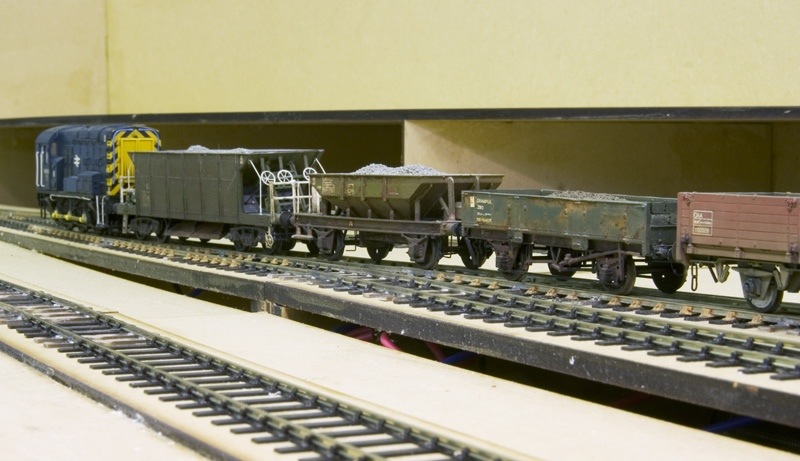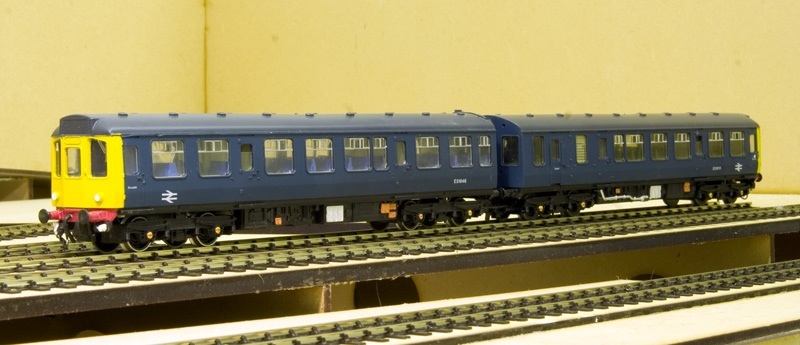DMU project – Done!
One of the things that struck me as a bit weird with the pics of the class 103 underframes I showed last time was that the bogies seemed to be too far inboard from the ends. The class 103 (and class 110 for that matter) have bogies centres of 40 feet but Hornby have them set closer to 38 feet. This is not something I’ve ever seen mentioned before with regards to the Hornby 110. On the trailer and the none powered end of the DMBS, because i had used Brassmasters bogies it was simply a case of moving the bogies out. Originally the mounting plate sat neatly inside the moulding (although raised by some 100thou evergreen strip. Now they sit outside of the moulding by 20thou as can just be seen in the picture. At the powered ens U opened out the floor at the inner end and simply bent the forward clip of the bogie to push everything back (the sideframes aren’t the best fit to the power bogie and were way to stiff before anyway!).
On the trailer and the none powered end of the DMBS, because i had used Brassmasters bogies it was simply a case of moving the bogies out. Originally the mounting plate sat neatly inside the moulding (although raised by some 100thou evergreen strip. Now they sit outside of the moulding by 20thou as can just be seen in the picture. At the powered ens U opened out the floor at the inner end and simply bent the forward clip of the bogie to push everything back (the sideframes aren’t the best fit to the power bogie and were way to stiff before anyway!).
The bogies have been backdated with bits of wire and microstrip.  Happier now. With that, some paint, the seating modified and some LEDs, aside from some windscreen wipers I can call these done.
Happier now. With that, some paint, the seating modified and some LEDs, aside from some windscreen wipers I can call these done.
Class 103
 The roof vents were kindly printed for my by my friend John Chivers and I extend my thanks.
The roof vents were kindly printed for my by my friend John Chivers and I extend my thanks.



Class 129



And finally both units together. 
The last few DMUs
 Long time followers will recall this old picture of a Hornby Class 110 DMU that I intended to chop up into something a little more ‘local’. With the acquisition of a Bachmann Derby lightweight as a gap filler it kind of fell off the radar a little. I did debate doing another class 100 but in the end I have decided that a Park Royal class 103 would be the target of my attentions.
Long time followers will recall this old picture of a Hornby Class 110 DMU that I intended to chop up into something a little more ‘local’. With the acquisition of a Bachmann Derby lightweight as a gap filler it kind of fell off the radar a little. I did debate doing another class 100 but in the end I have decided that a Park Royal class 103 would be the target of my attentions.
A little about the prototypes
These units were introduced in 1957 to the Birmingham LMR region. 20 sets were produced and the last vehicle in passenger use lasted until 1983. A few vehicles survived a little longer in departmental use (Derby RTC Lab5 lasting until 1991) or as a Sandite unit (1985). There was another oddity in that one set was converted to a Viaduct Inspection Saloon. This was withdrawn in 1978 but was saved for preservation.
The 20 sets were all allocated to the Birmingham area for their first decade operating mainly Walsall services before moving on initially to Chester then spreading further afield. Although none standard they did use the blue square coupling code so could work with the majority of other DMU types. Pretty early on they started to suffer from cracking in the bogie frames and their poor reliability saw steam hauled services return to many of their diagrams while the problems were sorted out. Aside from the oddballs mentioned earlier they only carried 2 liveries. Green (with or without whiskers and later with a small yellow warning panel) or BR Blue (small panel or full yellow end). None received blue and grey livery.
The Model
The similarity between a class 103 and the class 110 is reasonably obvious and (as with my class 100 and 114 conversions) the desired result can be achieved buy cutting parts out and shuffling them around, Plus a few spare panels from previous projects.
 The above diagram may be of assistance. The red lines are cuts or areas than need to be removed. The orange areas are surplus and the blue areas need filling in. On the driving trailer everything aft of the last door stays the same as the class 110. I didn’t cut into the roof.
The above diagram may be of assistance. The red lines are cuts or areas than need to be removed. The orange areas are surplus and the blue areas need filling in. On the driving trailer everything aft of the last door stays the same as the class 110. I didn’t cut into the roof.
 Initial stages of assembly. You can see the additional panel from another body shell in white.
Initial stages of assembly. You can see the additional panel from another body shell in white.
 Face on you can see where the windows are opened up to match the class 103. The new frames are 10 x 30 thou microstrip secured to the inner edges. Incidentally in working on this conversion I have come to the conclusion that the class 110 windows aren’t right as supplied. They need to be wider and the angles tops need a slight curve.
Face on you can see where the windows are opened up to match the class 103. The new frames are 10 x 30 thou microstrip secured to the inner edges. Incidentally in working on this conversion I have come to the conclusion that the class 110 windows aren’t right as supplied. They need to be wider and the angles tops need a slight curve.
 The 2 body shells after a coat of primer and more work with filler. The angled tumblehome Hornby used has been rounded off and any missing hinges replaces with etched ones from Southern Pride. I need to add another cental filler to the DMBS yet.
The 2 body shells after a coat of primer and more work with filler. The angled tumblehome Hornby used has been rounded off and any missing hinges replaces with etched ones from Southern Pride. I need to add another cental filler to the DMBS yet.
Why do one when you can do 2?
 While in a DMU kinda mood I have started work on a class 129 DPU using a DC kits body kit.
While in a DMU kinda mood I have started work on a class 129 DPU using a DC kits body kit.
A bit on this prototype as well
3 of these single car units were ordered from Cravens by the LMR. These had a none standard coupling code (yellow diamond) meaning that the could work with the original Derby Lightweights. Introduced in 1958 they lased until 1973 with one going to the RTC initially for brake testing but later for hydraulic transmission tests and gaining the name ‘Hydra’. None of the 3 survived into preservation. Although 55997 was initially allocated to Walsall it was 55998 that was most often to be found working int he Birmingham area during the late 1950s mainly on New Street to Walsall, Wolverhampton or Coventry services. Later it would regularity continue on to Rugby and one slightly unusual service was Alrewas to New Street with produce from market gardens. As with the other DPU class, class 128 they would regularly pull a tail load.
The Model
Charlie supplied his class 129 kit with a standard class 105 cravens DMU cab moulding (no doubt tooling up another cab just for this class of 3 units wouldn’t make a huge amount on commercial sense). So there is a little work to do to make it closer to the prototype, mainly removing the destination box and moving the marker lights down. I elected not to use the supplied flat bass etch for the route indicator box and made my own from microstrip.
 The main bodyshell assembled with extra little details. On something so plain sided it pays to add these little things to break up the sea of grey plastic
The main bodyshell assembled with extra little details. On something so plain sided it pays to add these little things to break up the sea of grey plastic
It’s alive!

With the track finished and wiring done the first train has had a run round the layout. Surprisingly for a first running session, nothing fell off! In the absence of suitable stock 08610 and a short rake of modern wagons did the honours!

I think my fascination with chopping up hornby class 110 DMUs is turning into a bit of an obsession! A quick browse on EBay saw another victim picked up cheaply (although this is the first time I’ve ever had a complete one). Question is what to do with it. Looking at some early ’60s pictures there’s a couple of options and I present the case for each below.
Class 100
For.
Seemed to be quite common in the area.
I’ve done one before so I know what to do
It appeals to my function over form tendencies.
Against.
I’ve done one before!
Class 103
For.
Quite an attractive looking unit
I haven’t done one before
Against.
Less common than the class 100s
Perhaps I need to ask my audience what they would prefer to see?
